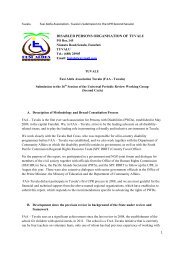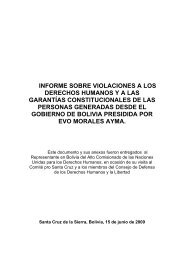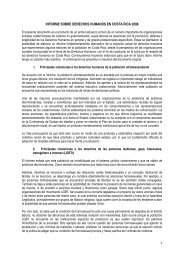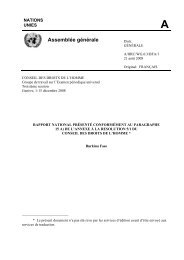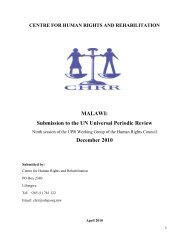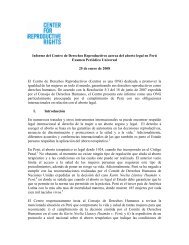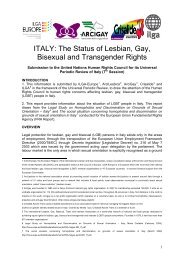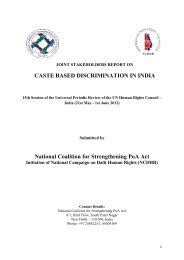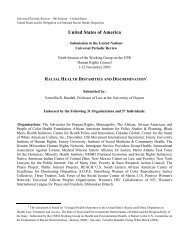Prison Needle Exchange: Lessons from a Comprehensive Review ...
Prison Needle Exchange: Lessons from a Comprehensive Review ...
Prison Needle Exchange: Lessons from a Comprehensive Review ...
You also want an ePaper? Increase the reach of your titles
YUMPU automatically turns print PDFs into web optimized ePapers that Google loves.
Expansion to other prisons<br />
At the same time as these developments were occurring at Oberschöngrün, plans were being<br />
developed for a pilot needle exchange program in the Hindelbank Institutions for Women. 132<br />
The Hindelbank project has its foundations in a 1991 survey<br />
of prisoners conducted by the prison physician. This survey of<br />
injection drug use in the institution found that almost all the<br />
people who injected drugs in Hindelbank had shared syringes<br />
while incarcerated. Armed with these findings, the doctor proposed<br />
developing a pilot needle exchange program within the<br />
prison. This proposal was supported by the Swiss Federal<br />
Office of Public Health.<br />
The Hindelbank needle exchange pilot project was launched in<br />
1994 as one component of a broader health-promotion and harmreduction<br />
initiative that included prevention education, coun-<br />
selling, and condom distribution. In the short term, the program<br />
sought to reduce the harms <strong>from</strong> drug use and to prevent infection<br />
or reinfection by bloodborne pathogens such as HIV and hepatitis<br />
B and C. In the medium term, the program aimed to reduce the<br />
number of new drug users and of former users who relapse. While<br />
in the Oberschöngrün program syringes were distributed <strong>from</strong> the medical unit, the Hindelbank<br />
pilot project adopted a new approach. At Hindelbank, syringes could be obtained via automatic<br />
dispensing units that were placed in six discreet locations around the institution. These units<br />
operated on a one-for-one basis; inserting a used syringe into the machine would cause a new<br />
one to be released. New prisoners entering Hindelbank were given a “dummy” syringe that<br />
would operate the machine but were not themselves functional. During the first year of the pilot,<br />
5335 syringes were distributed.<br />
In 1996 and 1997, needle exchange programs were established in Champ Dollon prison<br />
(Geneva) and Realta prison (Graubünden) respectively. The Champ Dollon project follows<br />
the Oberschöngrün model of distribution of syringes through the medical unit, while Realta<br />
uses a single dispensing machine. In 1998, prison needle exchange programs were started at<br />
the Witzwil and Thorberg prisons in Berne. Both programs distribute syringes through prison<br />
medical staff. In 2000, the Saxerriet prison in Salez became the seventh Swiss prison to provide<br />
sterile needles. 133<br />
Insertion of used syringe in dispensing<br />
unit causes a new one to be released.<br />
Saxerriet <strong>Prison</strong>, Switzerland<br />
Evaluation and lessons learned<br />
The Hindelbank pilot project was the subject of an extensive scientific evaluation during its<br />
first year. 134 A series of structured interviews were conducted with the prisoners prior to the<br />
launch of the pilot, then again at three-, six-, and 12-month intervals.<br />
Eighty-five percent of the prisoners participated in at least one stage<br />
of the evaluation process. The interviews were supplemented with<br />
voluntary blood testing and information <strong>from</strong> other correctional<br />
sources.<br />
The evaluation found that syringe sharing virtually disappeared with<br />
the introduction of the pilot project. At the start of the pilot, eight of<br />
19 women who injected drugs admitted sharing syringes within the<br />
past month in the institution, two of these sharing with more than<br />
one person. At the end of the 12-month pilot, only one woman (who had been imprisoned<br />
just before the interview) admitted sharing a syringe. There was no evidence of an increase<br />
The evaluation found that<br />
syringe sharing virtually<br />
disappeared with the<br />
introduction of the pilot<br />
project.<br />
22 <strong>Prison</strong> <strong>Needle</strong> <strong>Exchange</strong>: <strong>Lessons</strong> <strong>from</strong> a <strong>Comprehensive</strong> <strong>Review</strong> of International Evidence and Experience



